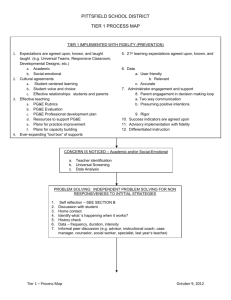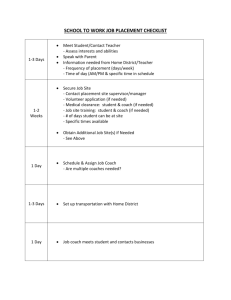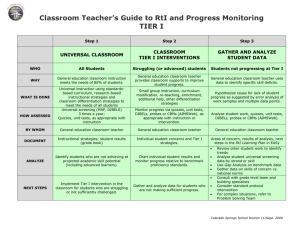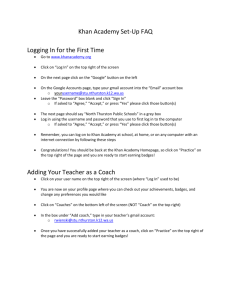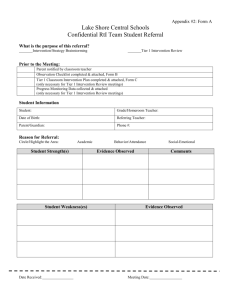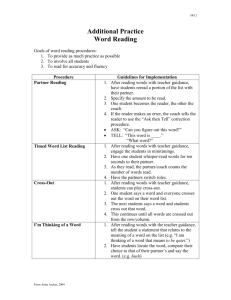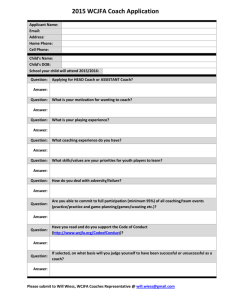Bridges Academy at Melrose
advertisement
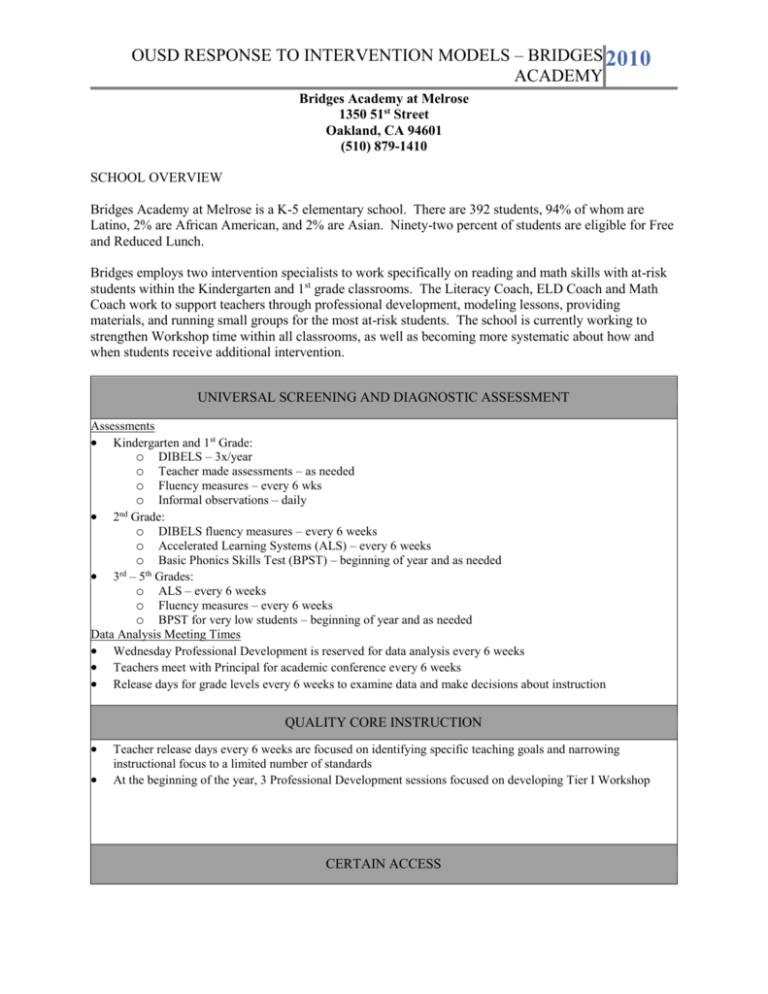
OUSD RESPONSE TO INTERVENTION MODELS – BRIDGES 2010 ACADEMY Bridges Academy at Melrose 1350 51st Street Oakland, CA 94601 (510) 879-1410 SCHOOL OVERVIEW Bridges Academy at Melrose is a K-5 elementary school. There are 392 students, 94% of whom are Latino, 2% are African American, and 2% are Asian. Ninety-two percent of students are eligible for Free and Reduced Lunch. Bridges employs two intervention specialists to work specifically on reading and math skills with at-risk students within the Kindergarten and 1st grade classrooms. The Literacy Coach, ELD Coach and Math Coach work to support teachers through professional development, modeling lessons, providing materials, and running small groups for the most at-risk students. The school is currently working to strengthen Workshop time within all classrooms, as well as becoming more systematic about how and when students receive additional intervention. UNIVERSAL SCREENING AND DIAGNOSTIC ASSESSMENT Assessments Kindergarten and 1st Grade: o DIBELS – 3x/year o Teacher made assessments – as needed o Fluency measures – every 6 wks o Informal observations – daily 2nd Grade: o DIBELS fluency measures – every 6 weeks o Accelerated Learning Systems (ALS) – every 6 weeks o Basic Phonics Skills Test (BPST) – beginning of year and as needed 3rd – 5th Grades: o ALS – every 6 weeks o Fluency measures – every 6 weeks o BPST for very low students – beginning of year and as needed Data Analysis Meeting Times Wednesday Professional Development is reserved for data analysis every 6 weeks Teachers meet with Principal for academic conference every 6 weeks Release days for grade levels every 6 weeks to examine data and make decisions about instruction QUALITY CORE INSTRUCTION Teacher release days every 6 weeks are focused on identifying specific teaching goals and narrowing instructional focus to a limited number of standards At the beginning of the year, 3 Professional Development sessions focused on developing Tier I Workshop CERTAIN ACCESS OUSD RESPONSE TO INTERVENTION MODELS – BRIDGES 2010 ACADEMY Intervention resources are mostly provided by additional support staff divided by grade level and not dependent on individual teachers During teacher release days, teachers discuss the most equitable distribution of intervention services based on needs of students within the grade as a whole RESEARCH BASED INTERVENTIONS Tier 2 groups use Results strategies with decodable books Tier 2 groups use the Systematic Instruction in Phoneme Awareness, Phonics and Sight Words program (SIPPS) www.devstu.org For Tier 1 Workshop and teacher-led interventions, teachers utilize strategies and activities based on the skill needs of the students. These activities come from Open Court, DIBELS’ based activities and teacher-created activities. While not all activities are part of research-based intervention programs, they are chosen specifically to address the 5 Big Ideas in reading. PROGRESS MONITORING Kindergarten and 1st Grade intervention groups are Progress Monitored using DIBELS Progress Monitoring measures; progress monitoring is completed by intervention specialists 2nd thru 5th grades have informal progress monitoring; they are working on establishing more formal methods of progress monitoring at this time. QUALITY PROBLEM SOLVING The Coordination of Services Team (COST), consisting of the Principal, Psychologist and Outreach Coordinator, meets every other week to discuss high priority students; there is not currently a formal referral process for this team. Resulting actions from this meeting may include: consultation with teacher, conversation with parent, referral to Student Study Team, or other follow-up measure. Students may be referred to the Student Study Team for academic, behavioral, emotional, attendance or community related concerns; the Outreach Coordinator receives referrals, collects background information on the student, and schedules meetings. Additional support staff such as the Psychologist, Resource Specialist, After School Program Coordinator or other teacher may be invited to attend if necessary. COLLECTIVE RESPONSIBILITY OUSD RESPONSE TO INTERVENTION MODELS – BRIDGES 2010 ACADEMY The 3rd grade is currently piloting a system where students are regrouped during a part of the Language Arts block based on level of need. Student data will be considered after 6 weeks and students will be rearranged into new groups based on their benchmark data and overall progress. At this point in time, all grades have opportunities for collaboration and consultation during release days and data meetings’ however, within the instructional day, teachers remain with their own classroom. BRIDGES ACADEMY AT MELROSE INTERVENTION STRUCTURE Tier I Workshop is expected from all classrooms for at least 30 minutes 3x/week; many teachers do workshop daily The Math Coach has created packets based on her assessment of low students to help guide differentiate instruction in this area The Math Coach consults with the Resource Specialist’s Instructional Aide to guide her work with low students The Psychologist is available for consultation during non-special education time (State and Federally funded) Tier II Kindergarten and 1st grade o A full-time Intervention Specialist offers before and after school intervention for teacher-identified students in 6 week cycles; students from the targeted classroom (a different classroom every 6 weeks) are identified by the teacher based on data and observations. o The IS divides his time during the school day between the 4 classrooms; in each class, a small group of teacher identified low students receive targeted intervention o Note: when a classroom has its turn for the before and after school intervention, these students receive Tier II twice daily: once before or after school and once during the school day. 2nd Grade: o There is no specific intervention for 2nd grade at this time. 3rd Grade: o Three times each week students are divided into four groups based on academic level in English Language Arts. The ten highest needs students including Special Education students work with the Literacy Coach, Resource Specialist and RSP Instructional Aide (RS and RS Aide focus on Special Education students but share resources and strategies with Literacy Coach). Another group of ten high needs students works with one of the 3rd grade teachers for small group intervention. The remaining 40 students are split among the remaining two teachers. o Learning targets for this leveled workshop time were determined during grade level release day 4th and 5th Grades: o English Language Development Coach provides intervention approximately 15-20 students in 8 week cycles, alternating between 4th and 5th grades. o The ELD Coach uses ADEPT, CELDT and ALS Benchmark data to determine which students require intervention. The BPST is also used to identify students for whom phonics skills are the primary need. o Learning goals center around comprehension and fluency strategies and are geared towards who students who are “stuck” in their English Language Development. Tier III: None at this time. OUSD RESPONSE TO INTERVENTION MODELS – BRIDGES 2010 ACADEMY
